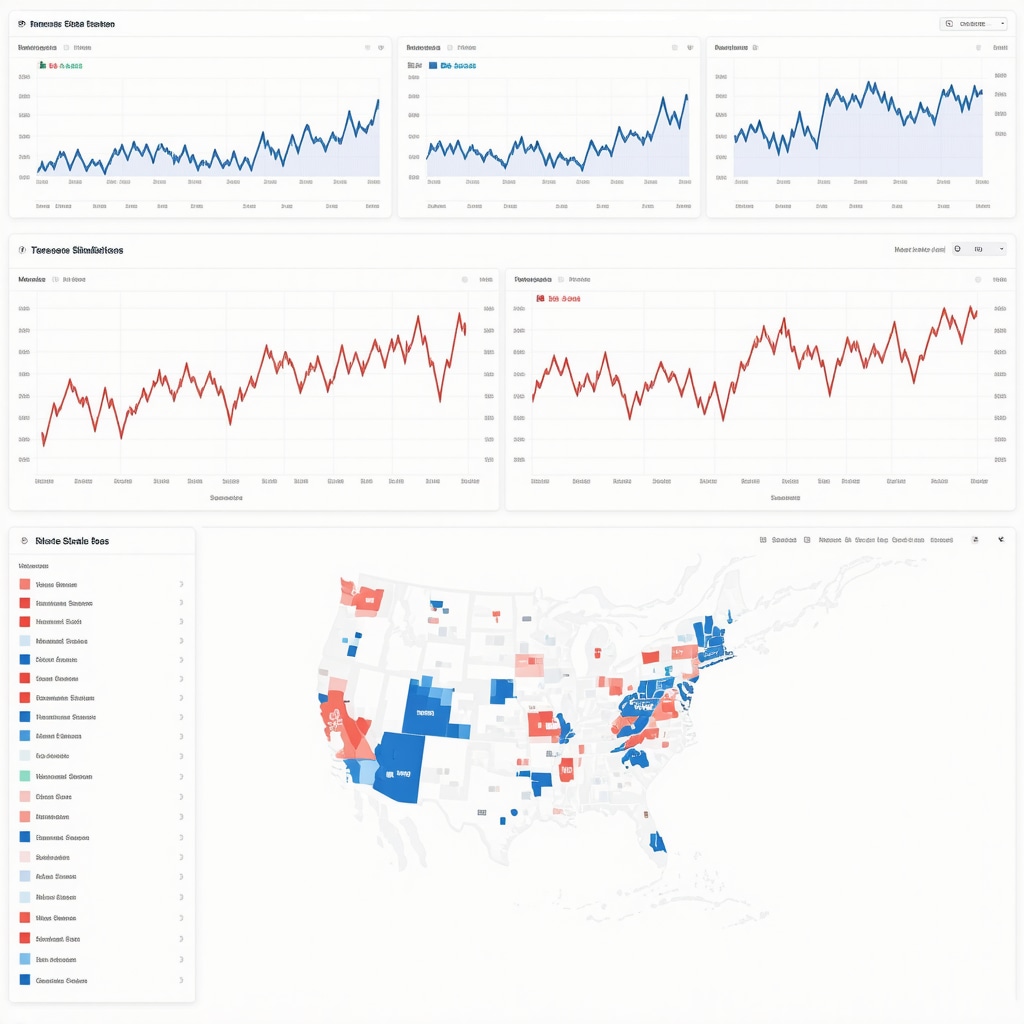Strategic Timing in Mortgage Rate Locking: Navigating Tennessee’s 2025 Market Dynamics
Securing an optimal mortgage rate in Tennessee during 2025 demands more than surface-level timing; it requires a sophisticated understanding of market volatility, economic indicators, and lender behaviors. As mortgage rates fluctuate due to macroeconomic forces such as Federal Reserve policies and inflation trends, homeowners and investors must strategically lock rates to maximize long-term savings and minimize risk exposure. This article delves into the nuanced timing strategies essential for Tennessee borrowers to confidently lock mortgage rates amidst shifting financial landscapes.
Decoding Tennessee’s Mortgage Rate Trends: An Expert Analysis
The Tennessee mortgage market in 2025 exhibits distinct regional variations influenced by economic growth rates in metropolitan hubs like Nashville, Memphis, and Knoxville. Advanced analytical models reveal that mortgage rates often experience intra-quarter volatility, with transient dips aligning closely with Federal Open Market Committee (FOMC) announcements. Understanding these patterns offers borrowers a tactical advantage to anticipate favorable locking windows. For instance, aligning mortgage rate locks immediately after Federal Reserve rate decisions can capitalize on temporary market corrections.
How Do Credit Scores and Local Economic Factors Influence the Optimal Lock Timing?
Creditworthiness remains a pivotal determinant in the mortgage rate locking strategy. Borrowers with higher credit scores typically access more competitive rates, increasing the leverage in timing locks strategically. In Tennessee, localized economic indicators such as employment rates and housing demand further modulate lender pricing models. Borrowers should not only improve credit profiles—refer to how credit scores shape your mortgage interest rates today—but also monitor regional economic reports to identify optimal locking windows that lenders may offer to stimulate borrowing during slower periods.
Balancing Fixed vs. Adjustable Rates in Lock Timing Decisions
Choosing between fixed and adjustable mortgage rates complicates the timing strategy. Fixed-rate locks offer certainty amidst market fluctuations but may come at a premium during periods of rising rates, whereas adjustable-rate mortgages (ARMs) can initially offer lower rates with potential exposure to future increases. Tennessee borrowers must assess economic forecasts and personal financial stability to decide when to lock either product. For a comprehensive understanding, consult the expert guide on navigating fixed vs adjustable mortgage rates.
Implementing Insider Strategies: When to Lock for Maximum Savings in Tennessee
Industry insiders recommend a proactive approach—locking rates during early-stage mortgage processing once pre-approval is secured but before formal underwriting to avoid last-minute market swings. Additionally, leveraging daily mortgage market insights—such as those detailed in daily mortgage rates update for Tennessee—can inform decisions on micro-trends in rate movements. Another proven tactic involves negotiating with lenders to secure a rate lock extension or float-down option, providing flexibility if rates decrease within the lock period.
What Are the Risks and Benefits of Early Versus Late Rate Locking in Tennessee’s 2025 Market?
Early locking secures a rate before potential hikes but risks missing out on lower rates if the market declines. Late locking allows waiting for favorable dips but exposes borrowers to sudden rate surges. Tennessee’s dynamic market necessitates weighing these trade-offs carefully, incorporating expert forecasts and personal risk tolerance. Engaging with knowledgeable mortgage brokers who understand these intricacies can provide bespoke timing advice tailored to individual situations.
For detailed strategies on locking refinance rates, explore refinance rates in Tennessee: when to lock for maximum savings.
Expert-Level Resources and Next Steps
Mortgage rate locking demands expertise not only in timing but also in navigating lender terms and regional market nuances. Professionals seeking to deepen their understanding are encouraged to review comprehensive analyses such as the essential tips for locking in a mortgage rate in Tennessee. Additionally, contributing your insights or engaging in expert discussions can enhance collective knowledge within the Tennessee mortgage community.
Explore advanced strategies and share your professional insights by contacting our expert team here.
As detailed in the Federal Reserve’s 2024 monetary policy review (Federal Reserve Monetary Policy), understanding macroeconomic signals is crucial for timing mortgage rate locks effectively, underscoring the intersection of economic policy and personal finance strategy.
Incorporating Inflation Expectations into Mortgage Rate Lock Timing
Inflation is a critical macroeconomic factor that influences mortgage rates profoundly. When inflation expectations rise, lenders often increase rates to maintain real returns. Tennessee borrowers who understand these dynamics can better time their mortgage rate locks by monitoring inflation trends, such as the Consumer Price Index (CPI) and Producer Price Index (PPI). Anticipating inflationary pressures enables borrowers to lock rates before anticipated hikes, thereby safeguarding against escalating borrowing costs.
Moreover, inflation can vary regionally, affecting Tennessee’s diverse metropolitan and rural areas differently. This regional inflation divergence necessitates borrowers to analyze localized economic data in addition to national metrics, enhancing the precision of timing strategies.
Leveraging Technology and Data Analytics for Smarter Rate Locks
Contemporary mortgage borrowers increasingly benefit from data analytics platforms that aggregate real-time mortgage rate movements, lender offers, and economic indicators. These tools empower Tennessee homebuyers and refinancers to execute data-driven locking decisions rather than relying solely on intuition or generic advice.
For example, predictive analytics algorithms can forecast short-term rate movements based on historical patterns and current economic signals, helping borrowers optimize their lock timing. Integrating these technological insights with expert consultation creates a powerful synergy for maximizing savings and minimizing risk.
How Can Advanced Data Tools Transform Your Mortgage Rate Locking Strategy in Tennessee?
This question challenges borrowers and professionals alike to explore the tangible benefits of adopting technology in mortgage decisions. By embracing data-driven methodologies, Tennessee borrowers can gain competitive advantages through timely rate locks aligned with nuanced market signals.
Access to platforms that provide localized rate trends, lender-specific lock options, and scenario analyses can transform traditional approaches into sophisticated strategies. For deeper insights, see daily mortgage rates update for Tennessee.
Understanding the Impact of Loan Types on Lock Timing and Rate Sensitivity
Different loan products exhibit varying sensitivities to market fluctuations, which directly affect optimal lock timing strategies. For instance, FHA and VA loans often have different rate structures and lock policies compared to conventional loans, influencing borrower decisions.
In Tennessee, where FHA loans remain popular among first-time homebuyers, understanding these nuances is essential. FHA loans may offer more flexible lock options but can also be subject to distinct pricing adjustments based on credit and loan-to-value ratios. Familiarity with these loan-specific attributes allows borrowers to tailor their lock timing to product characteristics, enhancing cost efficiency.
For a detailed exploration of FHA loan trends and opportunities in Tennessee, consult inside Tennessee’s FHA loan rates: trends and opportunities.
Negotiation Tactics: Securing Favorable Rate Lock Terms with Tennessee Lenders
Beyond timing, the contractual terms of rate locks—such as lock duration, float-down options, and extension fees—impact overall savings. Tennessee borrowers who proactively negotiate these terms can mitigate risks associated with market volatility.
For example, securing a float-down clause allows borrowers to benefit if rates drop after locking, a valuable feature in uncertain markets. Additionally, negotiating longer lock periods can provide protection against processing delays but may incur additional fees, necessitating a cost-benefit analysis.
Engaging local mortgage brokers familiar with Tennessee lenders’ policies can provide leverage in these negotiations. These professionals can advocate for customized lock agreements that align with borrower risk profiles and market outlooks.
What Are the Most Effective Negotiation Strategies for Locking Mortgage Rates in Tennessee?
This question invites industry experts and borrowers to share and analyze negotiation techniques proven to optimize mortgage rate lock outcomes. Strategies may include comparative lender shopping, timing lock requests around rate trends, and leveraging broker relationships.
Sharing your experiences or questions in the comments can enrich this discussion and support a community of informed Tennessee mortgage participants.
For additional expert guidance, consider reviewing how to choose a mortgage lender in Tennessee: top tips for 2025.
Integrating Inflation Hedging Techniques into Your Tennessee Mortgage Rate Lock Strategy
Inflation’s nuanced interplay with mortgage rates demands borrowers adopt hedging approaches beyond mere timing. Sophisticated investors and seasoned homebuyers in Tennessee increasingly consider inflation-protected securities and Treasury Inflation-Protected Securities (TIPS) yields as leading indicators for preemptive rate locking. By correlating TIPS breakeven inflation rates with mortgage rate forecasts, borrowers can anticipate lender behavior regarding margin adjustments linked to inflation risk premiums.
Moreover, advanced inflation hedging involves layering mortgage products with embedded features such as interest rate caps or buy-downs that can offset incremental inflation-driven rate rises. For Tennessee’s diverse economic regions, this strategy is particularly valuable during periods of regional cost-push inflation, where local wage and material cost surges can disproportionately affect lender risk calculations.
Harnessing AI and Machine Learning Models to Forecast Optimal Lock Windows
The advent of AI-driven analytics has revolutionized mortgage rate lock decision-making. Machine learning algorithms ingest vast datasets, including Federal Reserve announcements, regional employment statistics, housing starts, and even social sentiment analysis to predict rate movements with increasing precision.
For Tennessee borrowers, platforms employing these models can provide probabilistic forecasts indicating the likelihood of rate increases or decreases within specific timeframes. Integrating these forecasts with personalized financial profiles enables an adaptive locking strategy that evolves as market conditions shift.
How Do Machine Learning Predictions Compare to Traditional Mortgage Rate Forecasting Methods?
Traditional forecasting relies heavily on macroeconomic indicators and historical trend analysis, often lacking responsiveness to real-time market sentiment and microeconomic shocks. Machine learning models, conversely, dynamically update predictions by continuously learning from incoming data, capturing complex nonlinear relationships missed by conventional methods.
However, these models require rigorous validation and are subject to overfitting risks. Combining human expertise with AI insights ensures balanced decision-making, leveraging computational power without disregarding contextual nuances intrinsic to Tennessee’s mortgage market.
For a deeper dive into AI applications in mortgage rate forecasting, visit Mortgage Technology Insights: AI in Rate Prediction 2025.
Advanced Negotiation Tactics: Securing Customized Rate Lock Agreements in Tennessee
Negotiation sophistication extends beyond standard lock duration and float-down clauses. In 2025, Tennessee borrowers benefit from tailored agreements incorporating adjustable lock fees contingent on rate volatility indices or lender-specific risk metrics. Such arrangements can align borrower and lender incentives, fostering flexible yet protective terms.
Another emerging tactic includes bundling rate locks with mortgage servicing rights (MSRs) considerations, where lenders might offer preferential lock terms in exchange for servicing fee agreements. Navigating these complex negotiations requires deep lender knowledge and strategic leverage, often facilitated by veteran mortgage brokers or financial advisors well-versed in Tennessee’s lending landscape.
What Legal and Financial Considerations Should Borrowers Evaluate When Customizing Rate Lock Contracts?
Custom contracts may introduce variable fees, contingent liabilities, or lock expiration penalties that differ from standardized agreements. Borrowers must meticulously review contract language, preferably with legal counsel, to understand potential cost exposures and enforceability nuances.
Additionally, financial modeling of various lock scenarios, including stress testing against adverse rate movements, is critical to ensure that negotiated terms do not inadvertently increase long-term borrowing costs or limit refinancing flexibility.
Consult the Advanced Rate Lock Contracts: Legal & Financial Guide for comprehensive insights.
Quantitative Finance Techniques Elevating Mortgage Rate Lock Strategies in Tennessee
Advanced borrowers and financial professionals are increasingly integrating quantitative finance models—such as stochastic interest rate modeling and Monte Carlo simulations—to anticipate mortgage rate trajectories in Tennessee’s 2025 market. These sophisticated techniques allow for probabilistic risk assessments that transcend traditional deterministic approaches, enabling highly tailored lock timing strategies aligned with individual risk appetites and market scenarios.
Stochastic models, including the Cox-Ingersoll-Ross (CIR) and Hull-White frameworks, simulate the dynamic evolution of short-term interest rates, capturing mean-reversion and volatility nuances critical to mortgage pricing. Employing these models helps borrowers estimate expected rate paths and the probability distribution of future mortgage rates, facilitating decisions on whether to lock early or float based on quantified risk metrics.
How Can Monte Carlo Simulations Optimize Personalized Mortgage Rate Lock Decisions in Tennessee’s Volatile Environment?
Monte Carlo simulations generate numerous hypothetical interest rate paths by incorporating randomness and volatility parameters derived from historical and current market data. For Tennessee borrowers, running these simulations elucidates the expected range of rate outcomes during the anticipated lock period, quantifying downside risk and upside opportunity.
This stochastic approach empowers borrowers to make evidence-based lock timing choices, balancing potential rate decreases against the risk of increases. When combined with credit profile data and loan product specifics, Monte Carlo outputs enable precision in selecting lock duration and float-down features, optimizing cost efficiency.
Integrating Macroeconomic Event Calendars with Predictive Analytics
Proactive mortgage professionals in Tennessee leverage synchronized macroeconomic event calendars and real-time predictive analytics to refine lock timing. Tracking scheduled Federal Reserve meetings, CPI and PPI releases, and regional employment data feeds dynamic models forecasting imminent rate volatility spikes.
By anticipating market reactions to macroeconomic disclosures, borrowers can strategically lock rates immediately before or after key events to capitalize on transient rate dips or avoid volatility-induced spikes. This layered approach combines quantitative rigor with market intuition, delivering a competitive edge in rate optimization.
Advanced Hedging Strategies Utilizing Derivatives to Shield Against Rate Fluctuations
Institutional and high-net-worth Tennessee borrowers sometimes employ derivative instruments—such as interest rate caps, swaptions, and futures contracts—to hedge against adverse rate movements during the mortgage lock window. These instruments can complement traditional rate locks by providing downside protection while preserving upside flexibility.
Though generally more complex and accessible to sophisticated investors, integrating derivatives into lock strategies exemplifies the frontier of mortgage risk management. Collaborating with specialized financial advisors ensures appropriate structuring and compliance with regulatory frameworks.
What Are the Practical Considerations and Limitations of Using Interest Rate Derivatives for Mortgage Lock Hedging?
While derivatives offer tailored protection, they introduce additional costs, counterparty risk, and complexity in valuation. Tennessee borrowers must evaluate liquidity constraints, margin requirements, and the alignment of derivative terms with mortgage lock periods. Moreover, regulatory oversight mandates transparent disclosures and risk assessments.
Consequently, derivative-based hedging is best suited for those with substantial financial sophistication and access to capital markets expertise. For detailed regulatory and strategic guidance, consult resources like the Commodity Futures Trading Commission’s Interest Rate Derivatives Advisory.
Enhancing Rate Lock Outcomes through Collaborative Broker-Lender Analytics Platforms
The emergence of broker-lender analytics platforms in Tennessee facilitates data sharing and real-time collaboration, enabling more agile mortgage rate negotiations and lock timing decisions. These platforms aggregate lender risk appetite signals, pipeline volumes, and lock expiration metrics, granting brokers actionable insights to advocate effectively for borrowers.
Such integrated systems improve transparency and allow dynamic re-pricing or lock adjustments responsive to market shifts, reducing borrower exposure to unfavorable rate movements. This collaborative ecosystem exemplifies cutting-edge mortgage market innovation.
Engage with Our Expert Network to Leverage Advanced Mortgage Rate Lock Strategies
Unlock the full potential of these advanced methodologies by connecting with seasoned mortgage advisors and quantitative analysts specializing in Tennessee’s dynamic 2025 market. Our team offers bespoke consultations integrating quantitative models, macroeconomic analytics, and negotiation tactics tailored to your unique financial profile.
Contact us today to elevate your mortgage rate lock strategy with data-driven precision and expert insight.

Expert Insights & Advanced Considerations
Integrating Quantitative Models Enhances Lock Timing Precision
Employing stochastic interest rate models and Monte Carlo simulations allows Tennessee borrowers to move beyond guesswork. These quantitative finance techniques provide probabilistic forecasts of rate trajectories, enabling tailored lock timing strategies that quantify risk and opportunity, aligning with individual financial profiles and market volatility.
Negotiation of Rate Lock Terms Can Substantially Mitigate Market Risks
Beyond timing, securing flexible lock agreements—such as float-down options, adjustable lock fees, or extended durations—offers Tennessee borrowers critical protection against rate fluctuations. Expert negotiation with lenders, often facilitated by seasoned mortgage brokers, can translate into meaningful cost savings and risk reduction in volatile 2025 market conditions.
Advanced Data Analytics and AI Forecasting Transform Decision-Making
AI-driven platforms and real-time analytics harness macroeconomic data, regional housing dynamics, and lender-specific signals to forecast mortgage rate movements with increasing accuracy. Tennessee homebuyers who incorporate these tools gain a competitive advantage by aligning locking decisions with nuanced, data-driven market insights rather than relying on static forecasts.
Loan Type Sensitivities Necessitate Customized Lock Strategies
The diversity of loan products in Tennessee—from FHA and VA to conventional and jumbo loans—requires borrowers to understand how each responds uniquely to market shifts and lender pricing models. Tailoring lock timing to the specific loan type’s sensitivity enhances cost efficiency and secures optimal mortgage terms.
Regional Economic Indicators and Inflation Expectations Should Guide Timing
Localized Tennessee economic data, such as employment rates and regional inflation trends, directly influence lender rate adjustments. Borrowers who monitor these signals can anticipate rate movements more effectively, timing locks to capitalize on favorable market windows and hedge against inflation-driven rate increases.
Curated Expert Resources
Federal Reserve Monetary Policy Review: A foundational resource for understanding macroeconomic influences on mortgage rates, essential for interpreting Federal Open Market Committee decisions impacting Tennessee rates (Federal Reserve Monetary Policy).
Essential Tips for Locking in a Mortgage Rate in Tennessee: This comprehensive guide distills practical strategies and insider knowledge, helping borrowers navigate complex lock timing and negotiation (locking in a mortgage rate in Tennessee).
Inside Tennessee’s FHA Loan Rates: Trends and Opportunities: Deep dive into FHA loan specifics, enabling borrowers to align lock timing with product nuances (inside Tennessee’s FHA loan rates).
Daily Mortgage Rates Update for Tennessee: Real-time insights into rate fluctuations and lender offers, vital for spotting micro-trends that inform optimal lock decisions (daily mortgage rates update for Tennessee).
How Credit Scores Shape Your Mortgage Interest Rates Today: Understanding creditworthiness impact sharpens timing strategy by revealing when rate offers improve with score enhancements (credit scores and mortgage rates in Tennessee).
Final Expert Perspective
Mastering mortgage rate locking in Tennessee’s 2025 environment transcends simple timing—it’s a sophisticated blend of quantitative analysis, strategic negotiation, and localized economic intelligence. Borrowers who integrate advanced forecasting models, negotiate bespoke lock terms, and leverage data-driven insights position themselves to secure the most favorable rates amidst ongoing volatility. Recognizing the unique sensitivities of different loan types and regional inflation dynamics further refines these strategies, elevating cost efficiency and financial security.
For professionals and discerning borrowers alike, continuous engagement with authoritative resources and expert networks is indispensable. To deepen your expertise or share your insights, consider connecting with our expert team—your gateway to tailored guidance and cutting-edge mortgage rate lock strategies designed for Tennessee’s evolving market.

